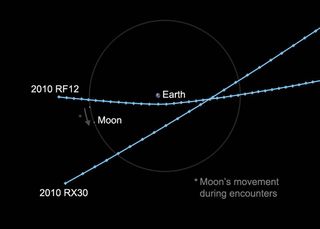2 Asteroids Zoom Between Earth and the Moon's Orbit

This story was updated at 6:03 p.m. ET.
Two asteroids passed close by the Earth Wednesday and may have been visible in telescopes as they zipped between our planet and the orbit of the moon.
The asteroids, which were not be visible to the naked eye, were discovered Sunday by astronomers with the Catalina Sky Survey near Tucson, Ariz. They are traveling along different orbits that, by coincidence, passed near Earth about 11 hours apart. [Photo of the asteroids' orbits near Earth.]
While scientists said neither asteroid threatened the planet, the two space rocks did provide a challenging skywatching opportunity.
"Both asteroids should be observable near closest approach to Earth with moderate-sized amateur telescopes," NASA officials said in a statement. "Neither of these objects has a chance of hitting Earth."
The larger of the two space rocks, asteroid 2010 RX30, flew by Earth first at about 5:51 a.m. EDT (0951 GMT). It is estimated to be about 33 to 65 feet wide (10 to 20 meters) and passed within 154,000 miles (248,000 km) of the planet. On average, the moon is about roughly 238,900 miles (384,402 km) from Earth.
The second asteroid is relatively small. Called 2010 RF12, it is estimated to be 20 to 46 feet wide (6 to 14 meters) and was expected to pass within 49,000 miles (79,000 km) a few hours later at 5:12 pm EDT (2112 GMT), NASA asteroid trackers said.
Get the Space.com Newsletter
Breaking space news, the latest updates on rocket launches, skywatching events and more!
Other asteroids have been known to make such close passes, but it is rare for two to be spotted zooming in at the same time. Most times, these types of asteroids slip by unnoticed, NASA scientists said.
A 33-foot (10-meter) wide near-Earth object, one of the some 50 million unknown asteroids estimated to exist, would be expected to pass between the Earth and orbit of the moon every day, according to NASA asteroid trackers. Such an asteroid could hit Earth's atmosphere once every 10 years, they added.
Because of the movement of two newfound asteroids, finding and tracking them across the sky was expected to be a challenge for even seasoned skywatchers.
"Advanced amateur astronomers may be able to track the asteroids?" the website Spaceweather.com reported. "The fast-moving space rocks will shine like stars of 15th or 16th magnitude."
Magnitude is a measure of how bright an object in the night sky is, with lower numbers corresponding to brighter objects. Anything magnitude 6.5 and above is not visible to the naked eye.
Using a network of telescopes on the ground and in space, NASA experts and other astronomers routinely track asteroids and comets that may fly uncomfortably near the Earth.
The space agency's Near-Earth Object Observations program is responsible for finding potentially dangerous asteroids and studying their orbits to determine if they pose a risk of hitting the Earth.
Join our Space Forums to keep talking space on the latest missions, night sky and more! And if you have a news tip, correction or comment, let us know at: community@space.com.

Denise Chow is a former Space.com staff writer who then worked as assistant managing editor at Live Science before moving to NBC News as a science reporter, where she focuses on general science and climate change. She spent two years with Space.com, writing about rocket launches and covering NASA's final three space shuttle missions, before joining the Live Science team in 2013. A Canadian transplant, Denise has a bachelor's degree from the University of Toronto, and a master's degree in journalism from New York University. At NBC News, Denise covers general science and climate change.
